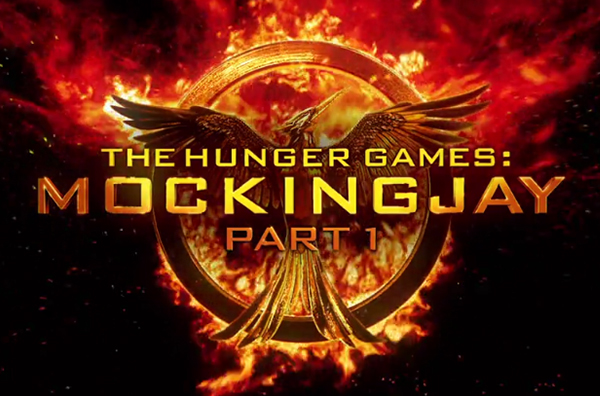Word and mind-games in The Hunger Games: Mockingjay Part 1

by Ted Giese
Francis Lawrence’s Mockingjay: Part 1 is the third movie in the film franchise based on the popular young adults book series Hunger Games by Suzanne Collins. Picking up after the events of the second film, Catching Fire, Katniss Everdeen finds herself under the care and custody of the people of District 13 who are waging a covert war against the Capitol and its leader President Snow.
The District 13 government lives in an underground military facility and is ready to move from its largely covert war efforts to a more active assault on the Capitol. However, it knows it can’t wage war alone, and seeks to gain the participation of people from the other twelve districts. Katniss has been rescued from a plot on her life by President Snow, who hoped her public death would act as a symbol of failed hope. Now she discovers she has been rescued for a purpose. District 13’s President Coin want Katniss to be as a revolutionary figure—someone around whom other districts will rally, someone to inspire them to join the revolution against the Capitol and its evil president.
Katniss begins the film as a reluctant participant in the plan. She feels guilty that Peeta Mellark, a love interest and fellow Hunger Games victor from her home district, was not rescued at the same time she was. As Mockingjay: Part 1 unfolds, the audience quickly sees that Peeta—like Katniss—is being used for propaganda purposes. But unlike the case of Katniss, we strongly suspect he is not a willing participant—a suspicion driven by his publicly transmitted interviews on behalf of President Snow and the Capitol. Katniss finally agrees to participate in the production of propaganda for the rebellion only if an attempt can be made to rescue Peeta from the Capitol along with others presumably being held captive.
As a Sheep Among Wolves…
Plutarch Heavensbee, the Head Gamemaker in Catching Fire turned revolutionary propagandist, discovers that Katniss’ strength as a revolutionary figure is found in her spontaneous and emotional reactions to unfolding events—a quality that can’t be effectively reproduced on a secret revolutionary bunker sound stage. As a result, Katniss is sent out into potentially dangerous environments with an embedded film crew to capture those hoped-for moments of inspiration.
In a way, she is being sent out like a sheep in amongst wolves. While she can handle herself in a fight, her sheep-like vulnerability lies in being singled out and pitted against much greater, ravenous enemies who want to destroy her. The rebellion hopes that, if the districts see this lone woman—who they already idolize because of the Games—stand up to President Snow then maybe they too will have courage to stand up against him. Still, the building hope that characterized the second film seems to have levelled off in this third film; over all, the film feels bleak, which isn’t too surprising considering its dystopian setting.
Katniss’ willingness to put herself in harm’s way for the good of others makes her as “innocent as a dove” but she and her fellow revolutionaries know they will need to be as “wise as the serpent” President Snow if they hope to win against him. President Snow is overtly described as a “snake” in the film, and his mode of attack is poison. While at times he wears a pristine wardrobe of white on white, the inside of his mouth is said to be riddled with physical wounds from his poisonous attacks.
Christian viewers may be reminded here of how Satan is described in Scripture. He “disguises himself as an angel of light,” we read (2 Corinthians 11:14). Likewise, Jesus says the devil was “a murderer from the beginning,” one who “does not stand in the truth, because there is no truth in him.” “When he lies,” Jesus continues, “he speaks out of his own character, for he is a liar and the father of lies” (John 8:44).
This film gives viewers an opportunity to think about the nature and ethics of propaganda. Is it legitimate to fight fire with fire? Is it possible to use propaganda in a positive way? What would that look like? Even in the context of this film, the revolutionaries are not free from using propaganda to manipulate. At one point, as she grieves in the aftermath of the destruction perpetrated by the Capitol against District 12, Katniss sings a morbid song from her childhood: “Are you, are you coming to the tree? Wear a necklace of rope, side by side with me.” But now the word “rope” is changed to “hope.”
When Jesus calls Christians to deny themselves and take up their cross and follow Him (Matthew 16:24), it isn’t to follow Him into physical warfare or rebellion against government. In Mockingjay: Part 1,many people die in open rebellion inspired and encouraged by Katniss Everdeen and her handlers. Viewers young and old may want to ask how well that fits with their religious and political convictions.
When Jesus calls Christians to deny themselves and take up their cross and follow Him, it isn’t to follow Him into physical warfare or rebellion against government.
There is also an additional lingering question hanging in the air: Would President Coin of District 13 be any better as Panem’s leader than President Snow? Viewers having trouble remembering who is and who isn’t an enemy may want to take a good look at the leader Katniss is fighting for in this new film.
Mockingjay: Part 1 is very different from the previous two installments in the franchise. It’s almost entirely devoid of the flashy dresses and opulent costumes of the previous two movies. There is no ‘Hunger Game’ in this film. Instead the ‘game’ is played outside the arena, with stakes much higher: everyone’s life is now on the line.
So is this a good movie? It’s hard to split a novel like Mockingjay into two parts. Consequently, the plot of this movie comes from what is mainly build-up in the early chapters of the book. All the way through, you feel the plot moving towards an explosive ending. And, while this film does provide an effective cliff hanger, it often feels like it’s not going anywhere fast. While Part 1 is mostly a war of words and propaganda, the second part is likely to be more action-packed. Fans of the Hunger Games franchise will enjoy the film and it will certainly tide them over until the final installment in November 2015.
——————–
Rev. Ted Giese is associate pastor at Mount Olive Lutheran Church in Regina. He reviews movies for both The Canadian Lutheran and Issues, Etc.



